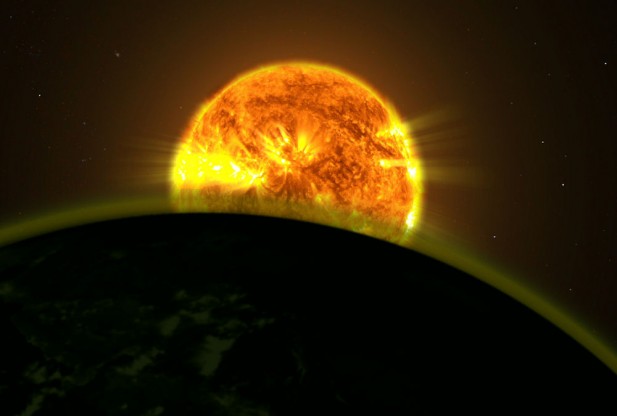
Two teams of scientists have discovered faint signatures of water in the atmospheres of five exoplanets. This is the first study to conclusively measure and compare the profiles and intensities of these signatures on multiple worlds.
"We're very confident that we see a water signature for multiple planets," Avi Mandell, a planetary scientist at NASA's Goddard Space Flight Center in Greenbelt, Md, and lead author of an Astrophysical Journal paper, said in a statement. "This work really opens the door for comparing how much water is present in atmospheres on different kinds of exoplanets, for example hotter versus cooler ones."
Scientist use space telescopes like Hubble to not only spot exoplanets, but also analyze their atmospheres. As a planet passes between its star and the Earth, researchers are able to analyze the atmosphere by determining which wavelengths of the star's light are transmitted and which are partially absorbed. During the latest study, the scientists used Hubble's high-performance Wide Field Camera 3, which is one of a few cameras capable of looking into the atmospheres of exoplanets trillions of miles away.
Observations were made in a range of infrared wavelengths where the water signature would appear. The teams compared the shapes and intensities of the absorption profiles, and the consistency of the signatures helped confirm they saw water.
"To actually detect the atmosphere of an exoplanet is extraordinarily difficult. But we were able to pull out a very clear signal, and it is water," L. Drake Deming of the University of Maryland in College Park, whose team reported results in the same journal, said in a statement.
The team said the water signals were less pronounced than expected, which could be due to a layer of haze or dust blanketing each of the five planets. This haze can reduce the intensity of all signals from the atmosphere in the same way fog can make colors in a photograph appear muted. Haze also alters the profiles of water signals and other important molecules in a distinctive way.
The five planets in the study, WASP-17b, HD209458b, WASP-12b, WASP-19b and XO-1b, all orbit nearby stars. They are all hot Jupiters, which are massive worlds that orbit close to their host stars. WASP-17b, a planet with an especially puffed-up atmosphere, and HD209458b had the strongest water signals.
The scientists were initially surprised to find all the planets were hazy, but some team members noted that other researchers are finding evidence of haze around exoplanets.
"These studies, combined with other Hubble observations, are showing us that there are a surprisingly large number of systems for which the signal of water is either attenuated or completely absent," Heather Knutson of the California Institute of Technology, a co-author on Deming's paper, said in a statement. "This suggests that cloudy or hazy atmospheres may in fact be rather common for hot Jupiters."



To really find Earthlike planets, a scope bigger than Hubble is needed.
The Infrared Telescope "James Webb" is set for lauch next year.
The Far Infrared Telescope "SAFIR" is set for 2015.
The International X-Ray Observatory (IXO) is set for 2021.
The above are very large and capable instruments, no doubt about it.
But Hubble's replacement in visible light frequencies (ATLAST) is 2025 - 2035.
As a side note, all (or most) of us are familiar with the statements made by the Astronauts who landed on the Moon describing Earthrise. They were clearly awestruck. What was it about Earthrise on the Moon that moved them?
On Earth, we see the Moon and Sun at approximately 1/2 degree size. We are used to that. On the Moon, however, since the distance to the Earth is the same as Earth to Moon, and the Earth is 4 times the diameter of the Moon, we would see the Earth in a jaw-dropping 2 degrees size. 4 times as large as the Moon or Sun as seen from Earth.
Now, that would get your attention, if not bring tears to your eyes.
It would definitely move me.